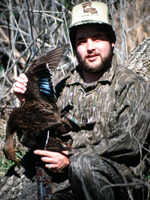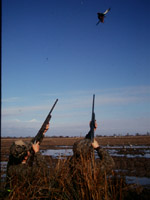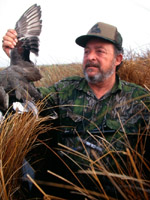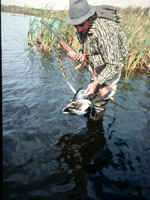
|
Features
|
|
|
|
Books
|
|
|
|
Fun & Games
|
|
|
|
Contact Us
|
|
|
John's Journal... Entry 117, Day 2
DUCKS WHEN THE WEATHER SIZZLES
Saltwater-Marsh Ducks
 EDITOR'S
NOTE: Like most duck hunters throughout the nation in the warm weather
of this past few seasons, I didn't hear the whistling wings of waterfowl
gliding out over the marsh, the constant quacking of mallards as they
fed in acorn flats or the whistling of wood ducks as they came in to roost
at night. Instead, the ever-present hum of mosquitos' wings -- millions
of them -- overpowered all the other sounds. However, while this past
year brought unseasonably-hot weather and many areas didn't see as many
ducks as they'd seen in other years, the sportsmen who knew how, where
and when to hunt quacks still found numbers of webfoots and took limits
of ducks, even though they may have killed over their limits of mosquitos.
EDITOR'S
NOTE: Like most duck hunters throughout the nation in the warm weather
of this past few seasons, I didn't hear the whistling wings of waterfowl
gliding out over the marsh, the constant quacking of mallards as they
fed in acorn flats or the whistling of wood ducks as they came in to roost
at night. Instead, the ever-present hum of mosquitos' wings -- millions
of them -- overpowered all the other sounds. However, while this past
year brought unseasonably-hot weather and many areas didn't see as many
ducks as they'd seen in other years, the sportsmen who knew how, where
and when to hunt quacks still found numbers of webfoots and took limits
of ducks, even though they may have killed over their limits of mosquitos.
After cranking our outboard motor, Rod and Eli Haydel and I traveled about
two miles from the shore into the marsh. When we pulled our aluminum johnboat
under a blind made of thatched-marsh grass, especially built to fit the
boat, we stepped out of the boat and onto planks 1 or 2 inches under the
water. The planks distributed our weight to keep us from sinking down
into the sucking mud of the marsh. As we walked to our blind, we flushed
hundreds of coveys of mosquitos that lurked in the grass looking for juicy
skin in which to drive their needle-sharp bills. After arriving at the
blind and using Yard Guard to eliminate the militia of mosquitos that
stood armed for combat around us, we stepped down into the three fiberglass
boxes with seats in them. Then we pulled the mosquito-free thatched marsh
grass over the blinds to ready for the morning's hunt.
 We
hunted from a blind the Haydels had utilized for many years. Sunk in the
mud in the marsh grass with a little pocket of open water in front of
the blind where ducks could land, the blind sat along a historical route
on the Mississippi Flyway that the ducks took from the rice fields to
the saltwater marshes each year. Because of the warmer-than-usual weather
and still winds, Eli Haydel used a diving-duck decoy tied to a string
running back to the blind to create wave action. "I can pull on the
string to make this little go-go girl decoy dive and turn her bottom side
up," Eli Haydel said. "By jerking the string, I can simulate
a feeding duck and create a little wave action on the water. Then passing
ducks will think my decoys are feeding and moving on the still water."
We
hunted from a blind the Haydels had utilized for many years. Sunk in the
mud in the marsh grass with a little pocket of open water in front of
the blind where ducks could land, the blind sat along a historical route
on the Mississippi Flyway that the ducks took from the rice fields to
the saltwater marshes each year. Because of the warmer-than-usual weather
and still winds, Eli Haydel used a diving-duck decoy tied to a string
running back to the blind to create wave action. "I can pull on the
string to make this little go-go girl decoy dive and turn her bottom side
up," Eli Haydel said. "By jerking the string, I can simulate
a feeding duck and create a little wave action on the water. Then passing
ducks will think my decoys are feeding and moving on the still water."
Two or three flights of gadwalls passed over our blind without giving us a second look, even though the Haydels called with the mastery bred from many generations of duck hunters. Later in the morning as three mallards came over the blind, the Haydels began to talk duck. "They're turning," Eli Haydel said. "Don't move." Although the ducks made a pass over the blind, they still flew out of gun range. When the greenheads had their backs to us, the Haydels both gave hailing calls, almost stopping the ducks in midair and causing them to circle back over the decoys. "Stay still, John," Rod Haydel said. "They'll need to go out and come back again if we want to take them." As the ducks approached the blind, the Haydels gave feeding calls. While flying straight ahead, the ducks looked down at the decoys and saw the diving decoy on a string moving around and appearing to feed. As the mallards started to leave, the Haydels once again cranked up their clear, plastic calls and lured the birds back toward the blind for the third and final trip.
 As
the ducks approached the decoys this time, they had their wings set and
their feet outstretched. Just as they frantically began to beat their
wings to land on the water lightly, Eli said, "take them." Two
mallard drakes dropped. Although we continued to shoot, a male and a susie
started escaping. With one shell remaining, Rod made a 45-yard shot and
cartwheeled one greenhead in the sky. "Being able to make long shots
like that one is why I like to shoot Bismuth shot," Rod said. "The
shells may cost more, but you really can reach out and touch a duck much
more effectively with Bismuth than you can with steel shot."
As
the ducks approached the decoys this time, they had their wings set and
their feet outstretched. Just as they frantically began to beat their
wings to land on the water lightly, Eli said, "take them." Two
mallard drakes dropped. Although we continued to shoot, a male and a susie
started escaping. With one shell remaining, Rod made a 45-yard shot and
cartwheeled one greenhead in the sky. "Being able to make long shots
like that one is why I like to shoot Bismuth shot," Rod said. "The
shells may cost more, but you really can reach out and touch a duck much
more effectively with Bismuth than you can with steel shot."
 As
Eli's dog retrieved the ducks, I talked with Rod about how to hunt these
hot-weather saltwater-marsh quacks. "Today we've called more to the
flights of ducks than we normally will in hot weather," Rod said.
"Usually when the weather gets really hot, the less calling you have
to do to bring the ducks in, the better the ducks respond. During warm
weather, don't try to blow the reed out of your call. Use more feeding
calls and only a few loud hailing calls. The ducks generally will feed
in dry rice fields at night or early in the morning and then fly to this
marsh at daylight. However, this year the abundance of rain has kept the
rice fields flooded. The ducks can stay and feed in the rice all day.
Even though we may get some duck movement early in the morning, we'll
have some of our best hunting later in the morning. As fishermen and duck
hunters start moving around in the marsh, they'll flush the ducks unintentionally.
Then the birds will have to find a place to light down."
As
Eli's dog retrieved the ducks, I talked with Rod about how to hunt these
hot-weather saltwater-marsh quacks. "Today we've called more to the
flights of ducks than we normally will in hot weather," Rod said.
"Usually when the weather gets really hot, the less calling you have
to do to bring the ducks in, the better the ducks respond. During warm
weather, don't try to blow the reed out of your call. Use more feeding
calls and only a few loud hailing calls. The ducks generally will feed
in dry rice fields at night or early in the morning and then fly to this
marsh at daylight. However, this year the abundance of rain has kept the
rice fields flooded. The ducks can stay and feed in the rice all day.
Even though we may get some duck movement early in the morning, we'll
have some of our best hunting later in the morning. As fishermen and duck
hunters start moving around in the marsh, they'll flush the ducks unintentionally.
Then the birds will have to find a place to light down."
TOMORROW: FRESHWATER-MARSH HUNTING
Check back each day this week for more about Ducks...
Day 1 - Hunting Warm-Weather
Ducks
Day 2 - Saltwater-Marsh Ducks
Day 3 - Freshwater-Marsh Hunting
Day 4 - Field Hunting
Day 5 - Great Lakes Ducks